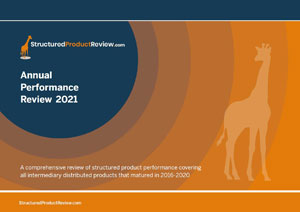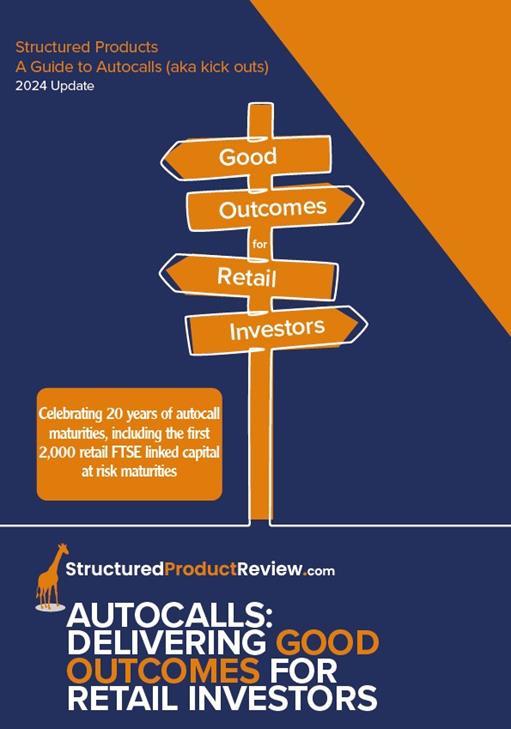GE Life High Income & Growth Plan V (Growth Option)
- Launched May 2001
- Bank of England base rate at time of launch 5.25%
- Growth plan linked to the performance of the Euro Stoxx 50 Index
- Inferred investment term: 3 years
- Actual investment period: 3 years, 9 1/2 weeks
- Headline growth rate: 33%
- Final Index Level was the lowest level (intraday, not necessarily closing prices) of the index between 30th July 2004 and 9th September 2004
- 2 x American intra-day capital protection barriers
- Primary barrier: 80%
- Secondary barrier 70%
Typical of the zeitgeist pertaining to the dark days of precipice bonds, the convoluted plan detailed above tempted investors and their advisers with attractive headline returns displayed in large font, but in exchange for a high degree of risk. The significant risk factor for this plan, defined as a ‘precipice bond’, is the potential 2% for 1% downside. This, coupled with other unfair terms meant it was one of the plans that we publicly condemned at the time of launch. A review of this plan offers an insight into some of the highly questionable products on offer in 2001, and when compared to what is typically on offer in 2021 (as below), should assure intermediaries and investors of how far the sector has come.
Mariana 10:10 Plan July 2021 (Option 2)
- Launched in May 2021
- Bank of England base rate at time of launch 0.10%
- Autocall / kick-out plan linked to the performance of the FTSE CSDI
- Term inferred: Maximum 10 years, 2 weeks
- Actual maximum investment term: 10 years, 2 weeks
- Opportunity to mature early on any anniversary from year 2 onwards
- Headline potential gain: 9.20% per year held if the Index closes equal to or above the Initial Index Level
- Final Index Level: closing level of the Index on 16th July 2031
- European capital protection barrier at 70%
Using the plan above as a contemporary comparative example, the most obvious differentiator is that the 2021 plan is an autocall, rather than simple growth plan. Autocall / kick-out plans did not exist back in 2001 with the first being launched in 2003 and have since grown to dominate UK sector issuance, accounting for more than half of all plans issued over the last decade.
Beyond this, the next big difference comes with the discrepancies between the investment term inferred, and the actual investment term. The GE Life plan was advertised as a three-year plan, when in reality there were 9 additional weeks – representing an extra 9 weeks of unrewarded risk being taken on by the end investor. In 2021 most plans have a maximum of two additional weeks to allow for settlement and these are always clearly outlined on the brochure cover.
Another nuance of the 2001 plan is the unfavourable measure used to determine the final index level. With the GE plan, the aforementioned additional 9 weeks were used to observe the lowest one second index level within that period, which was then utilised to determine the capital return. This clearly disadvantages the investor, representing an additional degree of risk that is no longer present in the sector today.
A further significant dissimilarity is the implications if the capital protection barrier is breached. The GE plan issued in 2001 provides two protection barriers, a primary barrier of 80% of the Initial Index Level and a secondary barrier of 70%. If the Final Index Level (the lowest intra-day position of the index in the final three months) was below the start level by more than 20%, capital would have been lost at a rate of 1% for each 1% fall in the index. However, if the Final Index Level was more than 30% down, capital would have been eroded at a rate of 2% for every 1% fall in the index. Consider also such a penal observation taking place in just three years’ time, compared to the alternative utilised in the 10:10 Plan where only if it has not matured positively on an earlier anniversary date will the 70% capital at risk barrier be observed, at close of business, on the tenth anniversary – and then of course, the maximum loss will be at a 1% per 1% rate. The longer potential duration gives time for the market to recover in the event of a significant correction and with the likes of the 10:10 Plan, the longer the duration, the greater the potential benefit of the snowballing coupons.
Following the mass distribution and mis-selling of products such as the GE Life plan, which was dubbed the precipice bond scandal, any downsides that exceeded the fall in the underlying were outlawed by the regulator. As such, capital-at-risk products released in the UK retail space since have had a maximum downside of 1:1.
Final results:
Final return for the 2001 GE Plan: As it was the market declined, with the punitive final index measurement being 36.7% below the initial index level, giving rise to a 73.4% reduction of capital.
Final return for 10:10 example above – To be established. But, knowing what you know, what do you expect? Unlike the three-year GE Plan where the potential for loss was significant, the calculated probability of the 10:10 Plan maturing with a gain on, or before the fourth anniversary, exceeds 70% (FVC).
An in depth analysis of the developments within the sector over the course of the last decade can be found in Lowes’ Retail Structured Product Sector Review of the Decade 2010 – 2019, accessible here.
Full details of the latest Mariana 10:10 Plan - September 2021, including Lowes’ Summary Papers, can be found here.
Structured investments put capital at risk.
Past performance is not a guide to future performance.
Disclosure of interests: Lowes has provided input into the concept, development, promotion and distribution of the 10:10. Lowes has a commercial interest in these investments as a result of its involvement. Where Lowes is involved in advice on these investments to retail clients, it will not receive benefit of any fees for its involvement, other than those fees payable by the client to Lowes.
Also in this section
- How old is too old? Are structured products to die for?
- Product focus - October 2024
- Q3 2024 Issuance
- Q3 2024 maturity results
- A share of spread bets on steroids?
- Product focus - September 2024
- Maturities of the month - August 2024
- Right on time
- Product focus - August 2024
- Keep calm and zoom out
- 2,000 and counting
- Q2 2024 maturity results
- 20 years of autocall maturities
- Product focus - June 2024
- Fixed income or interest?
- Maturities of the month - May 2024
- The barrier debate - revisited
- Product focus - April 2024
- Maturities of the month - April 2024
- Time to call
- I don't believe markets are ever too high for Structured products!
- Notes on counterparty exposure
- Return of Nikkei
- Q1 2024 issuance
- Q1 2024 maturity results
- Structured Products – AAAAAGH!
- Hop in CIBC
- Re-enter Santander
- How to build a financial fortune - revisited
- Issuance in 2023
- Where's the risk?
- Questionable offerings
- Challenging the case against structured products - 'Loss of dividends'
- Navigating the investment landscape
- Challenging the case against structured products - Counterparty risk
- 6-year autocalls approaching final destination
- 1,750 FTSE capital at risk autocall maturities
- The leopard that changed her spots
- Q3 2023
- Challenging the case against structured products - Keydata
- Dilemmas for UK IFA's and the unique role of Structured Products
- 'High charges'
- Precipice bonds
- Intro
- FTSE 100 Contingent Income
- Indexing the indices
- Something different
- Investing through volatility
- 100 10:10s
- The best or worst?
- The 10%/25% 'Rule' that never was
- Structured products and the yield curve
- Fixed income: Capital at risk?
- Prospects for UK inflation - and fun with A.I!
- The Barrier Debate
- More Deposits for now
- Last of the Americans
- What if?
- Time heals all wounds, we hope...
- How to diversify portfolios using structured products?
- The Proof Is In The Pudding...
- Debunking Structured Misconceptions
- 1,500 FTSE Capital-at-Risk Autocall Maturities
- Q3 2022 Maturity Results
- What do we prefer?
- Deposits vs Capital ‘Protected’
- There’s time yet…
- Where did you invest your clients?
- A Six-Month Reflection
- Return of the Rev Con
- Happy 2nd Birthday FTSE CSDI
- Q2 2022 Maturity Results
- The best and worst yet still the best
- Critique my Suitability - Mariana 10:10 Plan June 2022 (Option 2)
- 10/10 for 55 10:10’s
- Q1 2022 Maturity Results
- 'How to build a financial fortune': a follow up
- Critique my Suitability - Mariana 10:10 Plan April 2022 (Option 2)
- 2021 Capital-at-Risk Autocall Maturity Review
- An unwelcome return...
- CSDI's First Birthday
- Bon Anniversaire
- Introducing the FTSE Custom 100 Synthetic 3.5% Fixed Dividend Index
- Q3 2021 Maturity Results
- Critique my Suitability - Mariana 10:10 Plan October 2021 (Option 2)
- Blurring the lines...
- Beware of false knowledge; it is more dangerous than ignorance
- Good news, bad news...
- Certainty is Certainly a Benefit
- Critique my Suitability - Mariana 10:10 Plan September 2021 (Option 2)
- A Twenty-Year Progression
- Q2 2021 Maturity Results
- Nine 8:8s Post Positive Returns in Falling Markets
- Critique my Suitability
- Q1 2021 Maturity Results
- Morgan Stanley’s Marvelous Maturity Medley
Current Products
We review the UK's retail structured investment sector, providing pertinent support for Professional Advisers and relevant research tools.
View all ⟶


